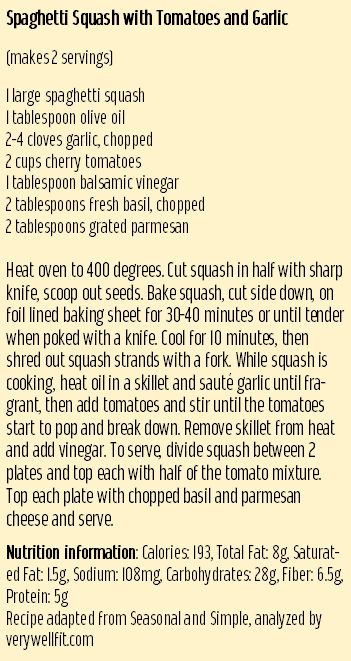|
|
by Denise Sullivan, Nutrition and Health Education Specialist, University of Missouri-Extension In the spring, when many people were having a renewed interest in gardening, my husband and I found ourselves a little late to the party. While we have always had a vegetable garden, we got a late start, due to my recovery from rotator cuff surgery.
Our tardiness, combined with the effect of frenzied seed and starter-plant purchasing by the masses, resulted in limited availability of some of our favorite varieties of plants. This led us to try some things that we have never grown before…including spaghetti squash. I’m not sure if it is really is this easy to grow or if the stars simply aligned, but if things continue as they are (in spite of squash bugs) we are looking at a bumper crop that should feed us well into the fall! While most squash are native to Central America, spaghetti squash was first recorded in Manchuria, China in the late 1800’s. It was then introduced to Japan in the 1920’s by the Aichi Prefectural Agricultural Research Station and improved by the Sakata seed company around 1934. In the later 1930’s, this squash variety was brought to North America by the Burpee company under the name of ‘vegetable spaghetti’. While it found a place in victory gardens in the 1940’s, it would take another thirty-something years to really gain popularity. Spaghetti squash is a type of winter squash, which are known for their hard rind and long storage life. Unlike other winter squash that have a smooth, velvety texture when cooked, this variety gets it’s name from the stringy, spaghetti-like strands that result after cooking. It is high in vitamins A and C, which are antioxidants that protect against heart disease and certain cancers. Vitamin A is also beneficial to eye health and Vitamin C helps to prevent bruising and aid skin and gum tissue in healing. Winter squash is also rich in potassium which aids in regulation of blood pressure. With this nutrient profile, it’s easy to see why this low calorie and high fiber vegetable is a popular pasta alternative among the calorie conscious. When selecting spaghetti squash, look for firm yellow squash that are about the size of a football and heavy for their size. They will keep for up to 2 months, when held in a cool dark place. It can also be cooked and frozen, though it may give off liquid after thawing, so plan to drain before serving. This squash can be cooked by boiling, microwaving or oven roasting. My preferred method is to cut in half and remove the seeds and roast on a foil lined baking sheet in the oven at 350 degrees for 30-40 minutes. I know many people who prefer to microwave or bake spaghetti squash whole, but it is important to remember to pierce the squash several times, with a knife or ice pick, to allow steam to escape during cooking, or it could possibly explode, leaving you with a big mess to clean. After cooking, scrape the squash to release the spaghetti like strands and serve with your favorite marinara or with a simple roasted tomato and garlic blend like the recipe that follows. Comments are closed.
|
Categories
All
Archives
July 2024
|
Grain Valley NewsGrain Valley News is a free community news source published weekly online. |
Contact Us |


 RSS Feed
RSS Feed
